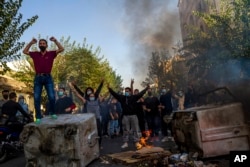Iran’s parliamentary elections on March 1 witnessed a historically low turnout, in a blow to the legitimacy of the clerical establishment.
The official turnout of 41 percent was the lowest for legislative elections since the 1979 Islamic Revolution. Critics claim the real turnout was likely even lower.
Hard-liners dominated the elections for the parliament and the Assembly of Experts, a body that picks the country’s supreme leader, consolidating their grip on power. Many reformists and moderates were barred from contesting the polls.
Experts said the declining turnout signifies the growing chasm between the ruling clerics and Iran's young population, many of whom are demanding greater social and political freedoms in the Middle Eastern nation of some 88 million.
“These elections proved that the overriding imperative for the Islamic republic is strengthening ideological conformity at the top, even at the cost of losing even more of its legitimacy from below,” said Ali Vaez, the director of the Iran Project at the International Crisis Group.
'Widening Divide'
Observers said disillusionment with the state has been building up for years and is reflected in the declining voter turnout in recent elections.
Turnout in presidential and parliamentary elections were consistently above 50 percent for decades. But the numbers have declined since 2020, when around 42 percent of voters cast ballots in the parliamentary elections that year. In the 2021 presidential vote, turnout was below 49 percent.
Ali Ansari, a history professor at the University of St. Andrews, puts that down to growing “despondency” in the country.
This is “the clearest indication of the widening divide between state and society, which has been growing over the years,” said Ansari.
“It is quite clear that the despondency is extending even to those who are generally sympathetic to the regime,” he added, referring to reformist former President Mohammad Khatami choosing not to vote in the March 1 elections.
Voter apathy was particularly evident in the capital, Tehran, which has the most representatives in the 290-seat parliament. In Tehran, only 1.8 million of the 7.7 million eligible voters -- or some 24 percent -- cast their votes on March 1, according to official figures.
Up to 400,000 invalid ballots -- many believed to be blank -- were cast in Tehran alone, a sign of voter discontent.
Ahead of the elections, nearly 300 activists in Iran had called on the public to boycott the “engineered” elections.
Beyond Boycott
The March 1 elections were the first since the unprecedented anti-establishment protests that rocked the country in 2022.
The monthslong demonstrations, triggered by the death in custody of a young woman arrested for allegedly violating Iran’s hijab law, snowballed into one of the most sustained demonstrations against Iran’s theocracy. At least 500 protesters were killed and thousands were detained in the state’s brutal crackdown on the protests.
Iran has been the scene of several bursts of deadly anti-establishment protests since the disputed presidential election in 2009. Many of the demonstrations have been over state repression and economic mismanagement.
But experts said that the 2022 protests alone did not result in the record-low turnout in the recent elections.
“This is a reflection of a deeper malaise that extends back to 2009 and traverses through 2017, 2019, and 2022,” Ansari said. “It has been building for some time.”
Despite the historically low turnout, Supreme Leader Ayatollah Ali Khamenei praised the “epic” participation of the public. State-run media, meanwhile, spun the elections as a victory over those who called for a boycott.
By claiming victory, the clerical establishment “overlooks the growing absence of support from 60 percent of its population,” said Vaez.
“Such self-approbation [mirrors] the regime’s previous dismissal of the 2022 protests as the result of foreign intrigue rather than reflection of deep discontent,” he said, adding that it represents the Islamic republic’s “continuation of ignoring simmering public discontent.”
Hard-Line Dominance
Around 40 moderates won seats in the new parliament. But the legislature will remain dominated by hard-liners.
The elections were largely seen as a contest between conservatives and ultraconservatives.
“We can say that a more hotheaded and previously marginal wing of the hard-liners scored a victory against more established conservatives,” said Arash Azizi, a senior lecturer in history and political science at Clemson University in South Carolina.
“This is because the former had a more fired-up base and in the absence of popular participation were able to shape the results,” he added.
A more hard-line parliament could have more bark but “certainly” not more bite than its predecessors, according to Vaez.
“The parliament is subservient to the supreme leader and rubber stamps the deep state's strategic decisions, even if grudgingly,” he added.
Since the ultraconservative Ebrahim Raisi, a close ally of Khamenei, was elected as president in 2021, Iran’s hard-liners have dominated all three branches of the government, including the parliament and judiciary.
Other key institutions like the Assembly of Experts and the powerful Guardians Council, which vets all election candidates, are also dominated by hard-liners.
“There is not much left of the system's republican features,” Vaez said. “The Islamic republic is now a minority-ruled unconstitutional theocracy.”
This content originally appeared on News - Radio Free Europe / Radio Liberty and was authored by News - Radio Free Europe / Radio Liberty.
